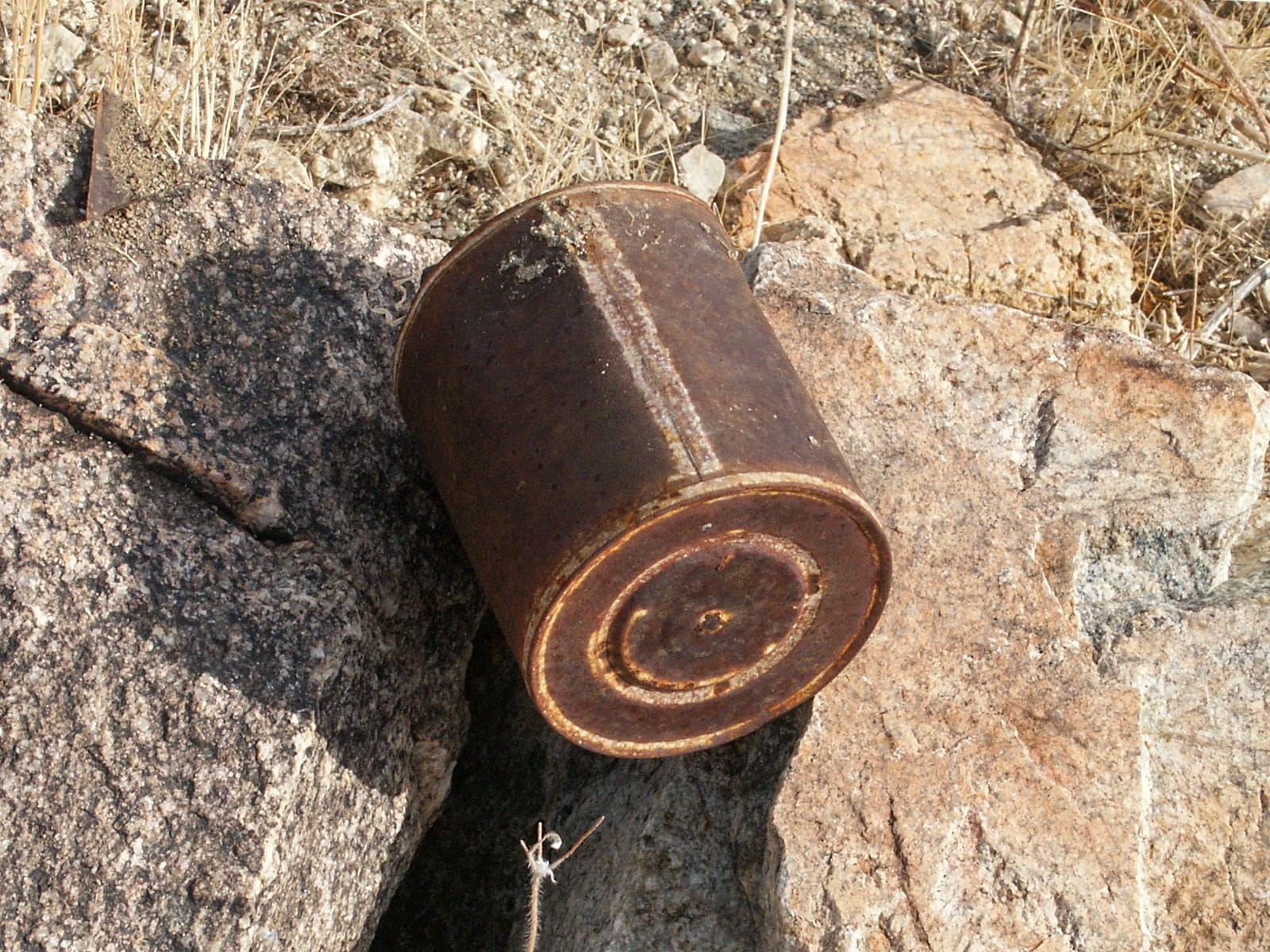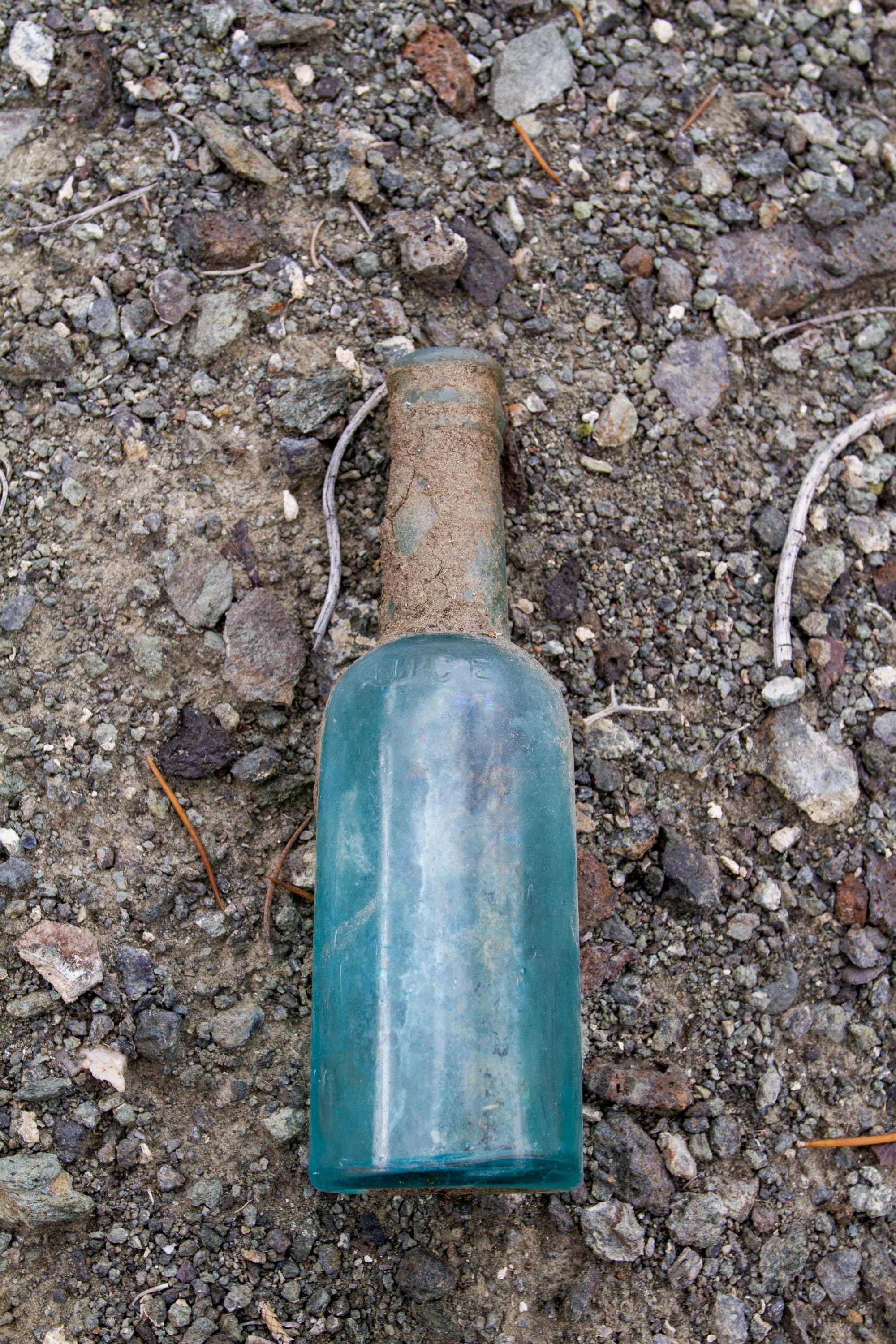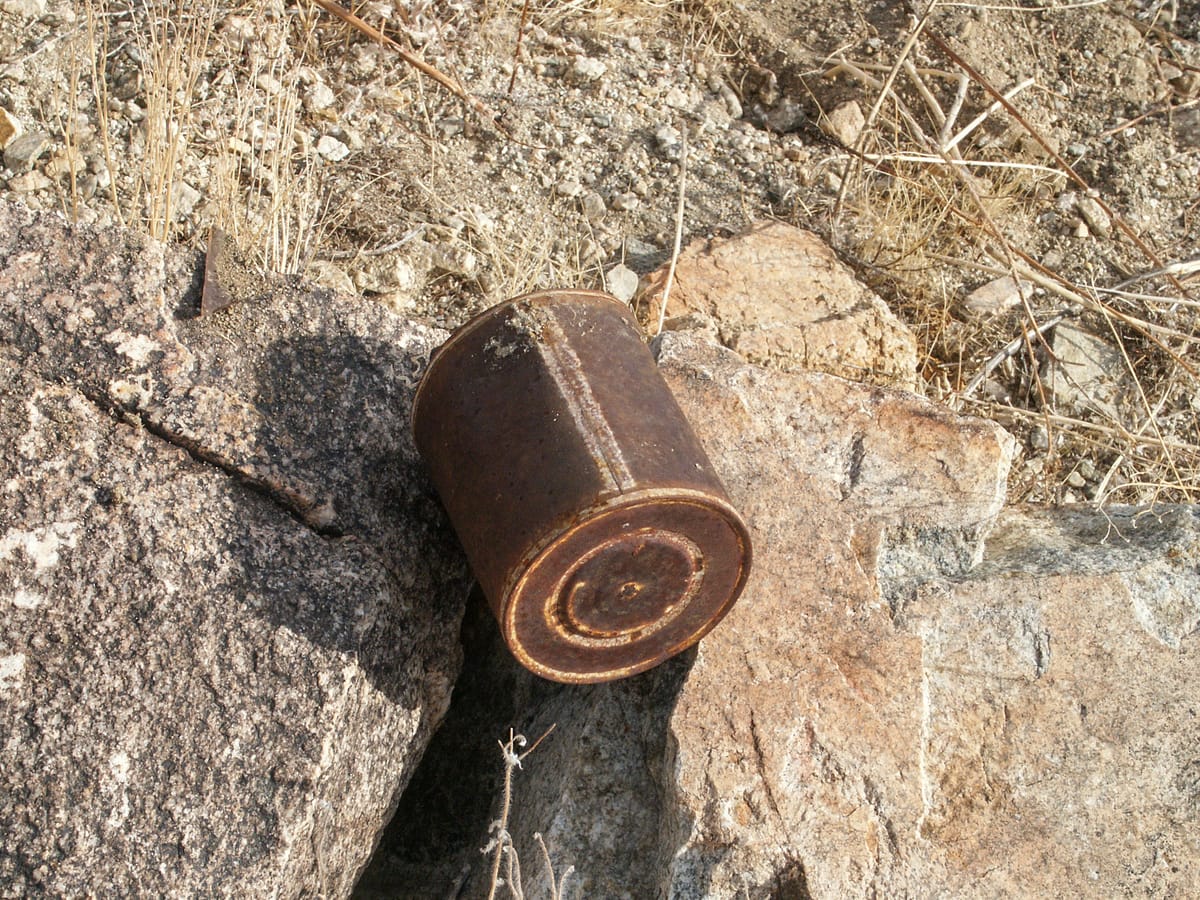Using artifacts to date historical sites
Cans
Food cans are widely overlooked as a good indicator of when a historical site was inhabited. And often, they are the only things left. What follows below is a basic guide.
The earliest cans have solder on all of their seams and are of the so-called "Hole-and-cap" design. Food was put in through the hole, and a cap was added and sealed with solder. There was no vent hole in these cans. These first cans were modified in 1825 to the "Hole-in-cap" style, where a center vent hole was added to the cap.
The can was heated and the cap was put on after the food was added to the can. The can vented through the hole while being heated, after which the vent hole was sealed with a dab of solder. Bacteria were unknown at the time, and the air itself was thought to cause food to spoil. Unfortunately, the terms Hole-and-cap and Hole-in-cap are sometimes confused with each other and used interchangeably. The difference is the center vent hole in the cap. Hole-and-cap designs lack a soldered center hole. Hole-and-cap cans are also understandably rare since they are so old. I've seen only a few in the wild.



Left: Hole-in-cap side-soldered can. Center: Side-soldered can that contained fruit. Right: Hole-in-top can.
Canned food became widespread in America with the 1849 Gold Rush to California. Miners coming west increasingly needed to rely on canned food as they prospected deeper into the wilderness of the Sierra Nevada and beyond. In the 1850s, Louis Pasteur discovered that bacteria caused food spoilage. This insight resulted in new can designs. Gail Borden first patented condensed milk in 1856. That same year, Henry Bessmer in England and William Kelly in the United States both discovered the process of converting cast iron into steel, which allowed less expensive cans to be produced. In 1859, a locking side seam for cans was invented, which further helped prevent spoilage.
The food demands of the Civil War (1861 to 1865) greatly spurred technological innovations in machinery, which increased can production. The U.S. Government was purchasing enormous amounts of Borden’s condensed milk for the Union army. In 1866, the first key-wind-opened sardine cans were produced. In 1883, the first machines capable of soldering the side seams of the cans were introduced, increasing can production.
Evaporated milk was first canned in the U.S. in 1885 by the Helvetia Milk Condensing Company using the new Hole-in-top design. This can was filled and vented through a small vent hole in the top of the can and lacked a cap. These cans are short and opened by punching two distinctive holes on opposite sides of the lid. Max Ams developed a double-side seam for cans in 1888, helping to make the cans airtight (but they were still soldered).
The Sanitary Can Company, founded in 1904, brought an important series of innovations to canning. Their cans had "Open top" lids that were crimped onto the can without needing a vent hole in the lid. For the first time, no solder was visible anywhere on the can, and the cans were completely machine-made. The Open top style cans also have the advantage of being fully open for filling at the factory and air-tight after heating and sealing. The name "Sanitary" was embossed on the lids, but this name only lasted until 1908 when the American Can Company absorbed the company. However, the new Open top or Sanitary style remained. The modern cans we have today are close variants of this style.
The tobacco can is another type of can you might see at an old mine camp. Chewing tobacco began to fall out of favor in the 1910s because of the unsanitary practice of spitting, which also helped give rise to modern cigarettes. The deadly 1918 Spanish flu pandemic brought spitting to the forefront of society and hastened the removal of spittoons from all public places, including saloons. Spitting on floors or sidewalks was frowned upon and illegal in many places then and is a sentiment that persists to this day. As a result, chewing tobacco cans are more likely to date from before the 1920s.
Simplified food can style guide
(Years are as close as possible and are approximate; there was overlap)
- From 1819 to 1847, cans are made completely by hand
- Hole-and-cap cans, all handmade: 1819 to 1825
- Hole-in-cap cans: 1825 to 1904 (but tend to pre-1890s)
- Machine-stamped embossed end cans: begin in 1847
- Crimped seams, hand side-solder cans: 1859 to 1888
- Hole-in-top (vent hole) cans: 1885 to 1905, but some continue later
- Double crimped seams, no side-solder cans: 1888 to 1904
- Sanitary can (“Sanitary” embossed on can): 1904 to 1908
- Open top, no solder (modern) cans: 1904 to present
Other cans
- Prince Albert tobacco cans: 1907 to present
- Friction type lid, loose pin hinge: 1907 to 1947
- Airtight lid, doubled over U-shaped lip: 1947 to present
- Key-wind opened cans: 1866
- Log Cabin shaped can: 1897 to 1955
- Hills Brothers first vacuum seals coffee: 1903
- Tuna first canned in California: 1909
- Key-opening collar can for coffee: starting in 1917
- Citrus juice was first canned in Florida in 1921
- Canned ham: starting in 1926
- Canned beer (enamel interior): first appeared in 1935
- Cone-top cans: 1935 to 1959
- Aerosol cans: starting in 1945
- All aluminum beer cans first appeared in 1959
- Soft drink cans: 1960
- Pull-tab can: 1962
- Modern Stay-Tab can: 1977
Bottles
An in-depth guide to bottle dating is far beyond our scope here. It is an extensive topic with many exceptions and complexities. What follows is only a very simple guide to bottles in the American West. It's important to note that these dates are general guidelines and there can be significant overlap and regional variations.
Bottle Mold Seams
- Free blown, irregular shape to 1880s
- No seams with horizontal striations on the body: Turn/Paste mold 1880 to 1915
- Seams up the body and laterally around the shoulder: Three-piece mold 1810 to 1890
- Seams only up the sides of the body: Two-piece mold 1848 to 1913
- Seams to within ¼" of the top: Semi-automatic bottle machine 1880 to 1913
- Seams go to the top and ring stem around the base: Automatic bottle machine 1905 to present
Bottle Embossing
- Embossing on panels: 1850 to 1915
- Embossed "Other Than Federal Law…": 1860 to 1915
- Embossed "Federal Law Forbids…": 1933 to 1960s
Bottle Color
- "Black," deep olive green, or "opaque": 1810s to 1880s
- Amethyst or purple: 1880s to 1920s
- Aqua: 1800s to 1930s
- Cobalt blue: 1840s to present
- Green: 1860s to present
- Amber or brown: 1860s to present
- White: 1870s to present
- Colorless or clear: 1880s to present



L: Neck from a dark green handmade bottle. C: clear bottle. R: Aqua bottle.
Nails
Perhaps surprisingly, nails can also be useful for dating historic sites. The earliest nails were hand-wrought nails, which were hand-made one at a time by a blacksmith from square iron rods. They would cut the nail to size, heat it in a forge, and work one end to a taper and point. They taper to a point on all sides. The head was created by pounding the other end in a “nail header,” which flattened out the end. These nails are rough and irregular and will show their craftsmanship.
As early as the 1790s, simple machines came into use to increase the production of nails. Cutting machines made square nails out of a rectangular iron bar. These nails have straight edges on all sides and taper on two sides to an end but without a point. Early square-cut nails often have irregular heads created by hammer strikes. After around 1830, these nail heads were machine-made and became more uniform. It's worth noting that square-cut nails are still made today, but only for specialty uses and in very low quantities.
In the 1890s, steel came into mass production using the Bessemer process. The steel wire nails that are common today quickly became dominant. By 1895, more than 75% of nails produced in the U.S. were wire nails.
A basic summary of the chronology of nails:
- Hand-wrought nails before 1800
- Square cut nails: 1790s to 1900s
- Wire (round) nails: 1890s to present
